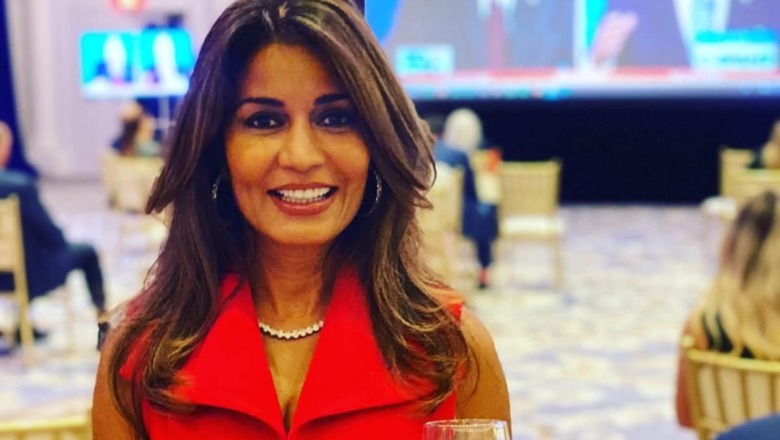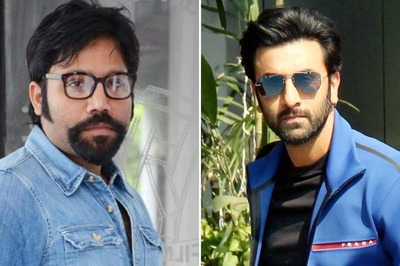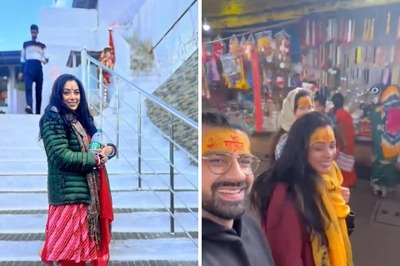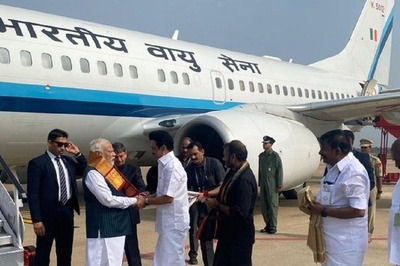
views
Mrinalini Kumari, is a renowned fashion designer based in New York, overseeing a trans-continental design enterprise. Her illustrious career includes crafting designs for icons like Beyoncé and global figures such as Michelle Obama. At the forefront of international haute couture, she’s sparking crucial dialogues on the global exploitation faced by Indian designers and artisans. Stemming from her personal challenges with Valentino, she poses a fundamental question: Does India, a flourishing hub for luxury design, receive its due recognition?
Let’s delve with her into the narrative of Indian designers versus their global counterparts.
- How ‘Made in India’ can be a coveted global label on strength of our superior craftsmanship and designs if we shake off the shackles of global exploitation and nor settle for being in the shadows?
Make in India for me is more than just a title and a business focussed approach – it is a sort of a reckoning of India’s globally prowess. From a fashion industry perspective, it is a symbol of our superior craftsmanship and designs and it is time that we break free and shine on our own terms.
We bring in a wealth of cultural heritage, traditional textiles, and our diversity that are critical especially when it comes to fashion designing.
Indian designers, are bringing in usage of sustainable materials and ethical practices in their production process. They are also raising awareness about the environmental and social impact of the fashion industry.
I think the time is ripe for us to own our place in the world – we possess a rich heritage of arts, crafts and techniques that no one can compare. We will however, need to work harder and bring Government and private sector together to play a pivotal role achieving superiority over other nations over fashion and designing.
Here are a few things that would help:
Embracing technology and investing in research and development across various industries to be making Indian products globally competitive.
Prioritizing strict quality control and certification standards, to be able to stand with global quality. This will need us putting in place a robust infrastructure, marketing, and financial assistance so as to encourage exports by reducing trade barriers and providing incentives to exporting companies.
Cooperation and networking: Integrate global design trends with regional handicrafts through networking and knowledge exchange.
I believe educated consumers also play an important role in awareness and the value of “Made in India” goods – we must leverage communication methods to create a demand for our products.
- What are the contributions of Indian fashion designers and artisans in shaping the global fashion industry?
Indian fashion designers and artisans have made profound contributions to the global fashion industry. They’ve showcased the rich tapestry of traditional Indian textiles, modernizing age-old weaving and dyeing techniques, bringing them international recognition.
Ethnic designs, including hand-painted motifs, block printing, intricate needlework, and mirror work, have influenced global fashion trends.
Indian designers have introduced cutting-edge styles in clothing, jewellery, accessories, and footwear, setting new standards for innovation and craftsmanship. Many have embraced eco-friendly and sustainable practices, aligning with international efforts to promote responsible fashion. Indian couture and bridal wear, epitomized by designers like Manish Malhotra and Sabyasachi Mukherjee, have garnered global attention.
Our fashion events are great platforms for international recognition – celebrity endorsements from Bollywood and beyond have amplified its reach. The empowerment of local artisans and collaborations with global fashion companies have preserved traditional craftsmanship and fostered cultural exchange.
Moreover, Indian fashion has championed diversity, both in body form and gender identity, aligning with a global trend towards inclusivity. Finally, Indian jewellery and accessory designers have made a lasting mark on the global fashion scene with their intricate, handcrafted creations.
In essence, Indian fashion designers and artisans have woven a tapestry of cultural richness, sustainability, and inclusivity into the global fashion industry, enhancing its diversity and creativity.
- The growing importance of sustainability in the fashion industry
In an era where we have collectively gone through worst of pandemics, the value of purpose and begin good to the earth has increase many fold.
Sustainability is a paramount need and challenge for the fashion industry due to a confluence of social, economic, and environmental factors. Environmental issues, including textile waste, resource overconsumption, and water pollution, highlight the significant ecological footprint of fashion, from raw material production to garment disposal. Sustainability initiatives aim to mitigate these environmental impacts.
What is fascinating to note is that Indian designers are possibly the foremost in coming with sustainable fashion – our history, heritage and natural resources have taught us the importance of sustainable materials – khadi, jute, cotton, usage of natural dyes, are some very basic examples.
Need for waste reduction, the importance of energy and water conservation, ethical labour practices, have all gained prominence today and governments and international organizations are working towards compelling businesses to adopt sustainable practices.
I think it’s simple to note that sustainability means long-term cost savings and community benefits. In essence, the fashion sector is driven by environmental responsibility and long-term business viability in a rapidly evolving market.
- What are the challenges that fashion designers, especially smaller or independent designers, face when it comes to protecting their designs and intellectual property in a highly competitive and often unregulated industry?
This is an interesting question and I am personally going through my own challenges to protect my craft – to be honest, it is not easy especially while dealing with big, establishments.
Smaller or independent entities like me are confronted with a multitude of challenges in safeguarding designs and intellectual property within the competitive and often loosely regulated fashion industry. Key hurdles include insufficient intellectual property (IP) protection, as fashion creations are frequently not covered by copyright, leaving designs vulnerable to copying, particularly by fast fashion retailers known for their rapid imitation and mass production.
Legal actions to protect IP can be financially burdensome, particularly when facing larger companies, and proving deliberate infringement can be intricate, requiring professional investigation.
Global supply chains add complexity, as coordinating IP protection across international borders is costly and challenging. The absence of standardized design protection mechanisms in the fashion industry, along with limited durations of protection and difficulties in protecting design elements through trade dress or trademarks, further compound the problem. Moreover, the ever-evolving nature of fashion design poses a continuous challenge.
Smaller designers may lack the legal expertise needed to navigate these complexities, relying on brand-building, marketing, and strategic alliances to mitigate these challenges. Collaboration with industry associations and legal professionals can provide essential guidance on design protection strategies.
Having said this, I think, an Indian origin designer and someone who is creating designs inspired by India, I am proud of what I bring to the industry and for that I am going to fight for what is right and for what is my rightful place.
5. What are the challenges you (Mrinalini Kumari) faced as an Indian fashion designer making a mark in a highly competitive American fashion market?
While, I must say that I did manage to create a niche for myself, the journey was difficult. There are certain obvious hurdles for Indians or anyone else coming from beyond the boundaries of usual European or American origins. At the same time, I also strongly believe that the fashion industry appreciates crafts and innovation that are authentic and contextual- anyone who brings in these has a place. One must remember to be true to their sensibilities and continue their journey.
- Discuss the fine line between inspiration and infringement in the fashion world.
The fine line between inspiration and infringement in the fashion industry is a multifaceted challenge with both legal and moral dimensions. Fashion thrives on creativity and innovation, drawing inspiration from diverse sources such as art, culture, history, and nature.
However, the critical distinction is highlighted when inspiration crosses the boundary into infringement. Copyright laws provide limited protection for fashion designs, making legal enforcement complex. Trademark and trade dress laws can safeguard certain elements of fashion, like logos and distinctive designs. Public perception and market impact are pivotal in determining whether a design is perceived as inspired or infringing.
The cyclical nature of fashion trends adds to the complexity, as designers frequently reinterpret past styles. Ethical considerations are also significant, with designers aiming to maintain their creative integrity. Industry guidelines and best practices help designers strike a balance, ensuring a dynamic and ethically sound fashion landscape. In this nuanced landscape, the fashion industry must navigate the fine line between inspiration and infringement to preserve both creativity and intellectual property rights while adhering to ethical and legal norms.
In conclusion, there is a blurry and arbitrary boundary in the realm of fashion between inspiration and infringement. Despite the existence of legal concepts and considerations, interpretation, context, and individual decisions are frequently crucial. To keep the fashion business vibrant and cutting-edge, designers and brands must strike a balance between their creative freedom and the need to uphold intellectual property rights and ethical norms.




















Comments
0 comment